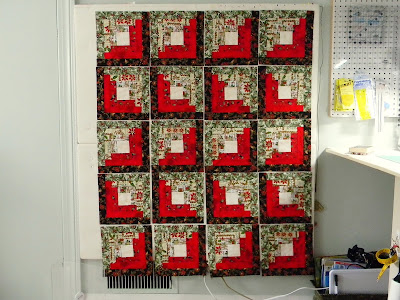
Until two weeks ago, this turtle fabric (click any photo to enlarge) had been teasing me from the fat-quarter shelf for a long time.
The trouble was, I wanted to use the turtles singly. But cutting almost any one of them out would mean chopping off some legs, or even worse, heads!
So a compromise was made. They were cut out in groups, which worked fairly well. (Missing toes simply appear to be covered with sand, which is fine.)
Arranged on a quarter-yard of sand-like Stonehenge (Northcott Mills) fabric, they became little hatchlings, heading as fast as they could go for the ocean (except for one...apparently the rebel in the bunch. We'll see him/her a few photos down).
This large-scale shallow-water fabric was a very recent purchase, and it was exciting to realize that already I had a use for it. A wavy edge was drawn on tracing paper and cut for the shoreline.
Three rocks were cut freehand from a dark Stonehenge fabric (the same fabric the castle was made from for the seascape panel in my June 9 blog post).
It quickly became apparent that the rocks would need some "grounding"--no floating rocks here.
So, a light source was decided upon and "shadows" were drawn on tracing paper and thread-traced (by machine in free motion, with clear thread) on blue-green tulle.
(Another piece of tracing paper was used on the back to stabilize and protect the tulle. The tracing paper tore off surprisingly well.)
The tulle shadow was then cut out with a "seam allowance" of roughly an inch, and sewn in place on the water (with one shadow edge tucked under the rocks) by stitching over the previously thread-traced lines, again with clear thread. The seam allowance was then removed by very careful trimming close to the stitching lines.
However, I wanted parts of the rock surfaces to be above water. So, other shapes were cut from white tulle, to be laid completely over the green shadows as well as the parts of the rock that were underwater. The same method was used to attach the white tulle.
The results were fairly satisfactory:
Here the quilt is pin-basted and ready to go on the machine:
But just before quilting it, it occurred to me there should be evidence of other creatures in the water, partly for added interest and better composition, but also for scale---meaning, I wanted some way to show that the turtles were freshly hatched and therefore very small.

Three of the easiest patterns I could think of to draw were a starfish, a sand dollar and a shell of some sort. Fortunately it wasn't hard to find suitable fabrics in my stash. These were embellished with nothing more than Sharpie markers, and fused to the quilt top, using my mini-iron (after removing a few basting pins to position them).
I thought about putting white tulle over them to emphasize their being underwater, but opted to skip the tulle and simply make sure my quilted water lines showed clearly over each applique.
Then it was time to quilt the sand. Darker, closer lines were stitched on the shadowy side of the turtles, and lighter ones on the lighter side, both in YLI variegated threads.
 |
Here's the rebel I mentioned earlier--the only one going in a different direction.
There's one in every family. :) |
At this point, the quilt looked like this:
I wasn't
unhappy with it, but not entirely happy, either. It needed something. And even as it came to me, my mind was already fighting it. After all, enough effort had already been made on this piece, in my opinion, what with the tulle and all. But no, deep down, I knew that a few hours were going to be added anyway--because what this quilt really needed was some
sea foam at the edge of the water.
Ay-yi-yi.
 |
| Just kidding about the two-thousand pins. But there were a lot of them. |
Out came a long, narrow piece of scrap polyester batting...and about two- thousand pins.
And more white tulle (not shown).
The batting was stretched, torn, shaped, and generally beaten into submission, pinning as I went, before it was then unpinned, covered with the tulle and re-pinned, one little section at a time.

The tulle was stitched with about an inch overlap on the sand side as well as on the water side, and trimmed very close to the stitching lines. Then the actual foam line on the sand was stitched, making the foam puff up to look more real. Three more flowing, wavy lines of stitching were spaced across the foam.
So, long story short, the difference made by this extra work was this (you'll have to scroll very quickly back and forth between the next two photos):
Next comes steam blocking (which makes the quilt hang much straighter and with even more "poof"), then trimming and binding. Then comes labeling and sleeving--is that a word? Anyway, the choice for binding color has been narrowed down to either a rust color or a teal. The teal seems to make the water look cooler and more inviting, but the rust makes the turtles "pop" more...and they are the stars of the quilt, after all (sorry, starfish). Also considering embellishing the turtles with some beads and/or metallic thread. We'll see.
Next time, the finished quilt, already titled "Catch a Wave."
Happy almost July!
Linda























































